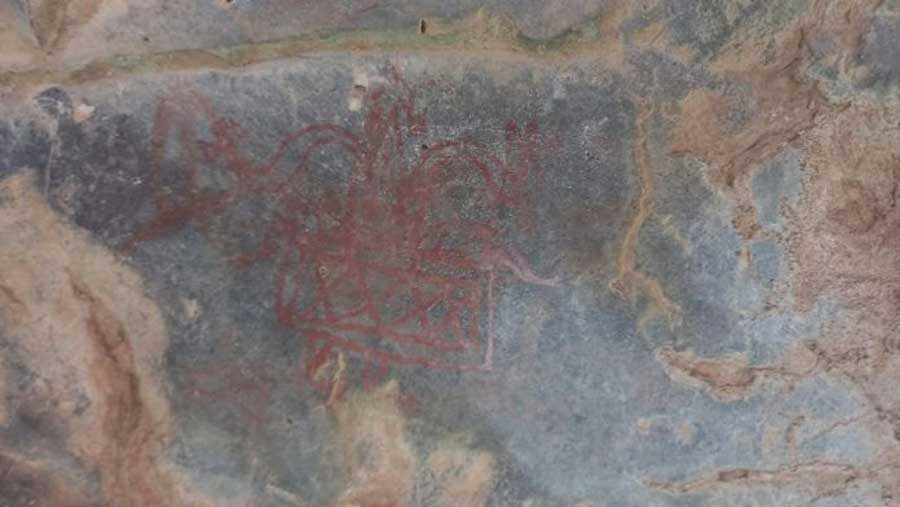Does Haryana Cave Hold the Oldest Art in India?
Hidden deep in India’s northwestern state of Haryana, archaeologists have discovered cave paintings dating to the Upper Paleolithic age. The cave art was found at Faridabad's Mangar Bani hill forest, within a matrix of lost caves in the region’s quartzite Aravalli mountain range. It is suspected this could be one of the oldest sites of human occupation in the country.
In the last week of June 2021, a team of archaeological explorers from the Haryana government’s museum and archaeology department explored a region near the forested Mangar Bani. Here they discovered hundreds of ancient cave paintings and rock art. Banani Bhattacharyya, deputy director of the department, told Hindustan Times that although the various artworks have not yet been dated, it is suspected that many were created “between 40,000 years and 10,000 years ago.”

The Haryana cave paintings and rock art were discovered in the Mangar Bani hill forest, an area under threat from illegal deforestation by developers. (Misha Bansal / Sancturary Nature Foundation)
Ancient Haryana Art Hidden by Plants for Thousands of Years
Bhattacharyya believes the site remained undiscovered for so long because of thick vegetation. The researchers say that while tools dating to the Paleolithic Age have been found in the Aravallis, this is the first time that cave paintings and rock art “of such a large magnitude” have been found in Haryana. Featuring humans, animals, foliage, and geometric shapes, some of the arts are located out in the open air. The majority of the best-preserved examples, however, are hidden on the ceilings of the rock shelters.
- World’s Largest Geoglyphs Found in India’s Thar Desert
- The Architecture and Spiritual History of India’s Famous Barabar Caves
The art is being associated with “a continuation with the Soanian culture” which has been found in Shivalik hills, Narmada and Aravallis,” said Bhattacharyya. The archaeologist, who was part of the discovery team, added that if the arts do indeed date to the Upper Paleolithic Age, then these findings “may well change the history of Haryana.”

Example of the cave paintings discovered in Haryana, India. (ANI)
Expectations at the Potentially History Changing Site
Ashok Khemka, principal secretary to government archaeology and museums department of Haryana, said that although a team from the department has conducted a preliminary study, further investigations will be undertaken. Archaeologists could, however, be getting ahead of themselves. Dating exercises at similar sites in India have been limited to analysis of the type of tools discovered. Nevertheless, in this case most of the cave paintings were created using red ochre, which means that the scientists expect to find analyzable, or datable, proteins within the pigments.
Indian Express say secretary Khemkas has already committed to granting “protection status to Mangar forest” of Haryana. Khemkas boldly claimed that the state archaeologists believe the art world will be dated back “roughly 20-30,000 years.” Khemka also said funds would be provided for a team of experts in prehistoric cave paintings, and that “locals and a few research scholars from the nearby universities will also be involved in the extensive survey.”
Sunil, a researcher from Haryana has discovered ancient artwork at caves in Mangar Bani hill forest. "There is rock art, paintings, figurines in these caves. Archaeology Department has also confirmed their ancient origin," he said pic.twitter.com/OeTHOZMfcC
— ANI (@ANI) July 18, 2021
A Haryana Stonehenge in the Making?
You would think everyone associated with heritage and archaeology in India would be just delighted with this announcement, but as usual these kinds of announcements provoke a varied response. Shalaish Baisla, an archaeology student and independent researcher, spoke with Hindustan Times to highlight the need for “immediate protection” at the new Haryana site.
Alarmingly, the student stressed, “there are individuals who have commercial interests in the area. It is crucial that the site is granted protection, even before any research is undertaken.” The Haryana cave art discovery will not be without its problems. The activist Sunil Harsana, also interviewed by Hindustan Times in relation to the Haryana discovery, stressed that while the forest definitely needed protection from developers this protection should not remain “on paper alone.”
- Ancient Hilltop Monastery Led by Female Monk Found in India
- Odd and Inexplicable Places in India Even Indians Don’t Know About!
As someone who fears for the future of the site, Harsana argued that sites such as this one “need to be protected so that future generations are able to understand the history of the region.” And while all this worry about commercial development surrounds the site, somewhere in India, and probably about to fund the next round of archaeological research, is a table of tourism giants rubbing together their hands.
Top image: Example of the Paleolithic paintings discovered in the Indian state of Haryana. Source: ANI
By Ashley Cowie



















